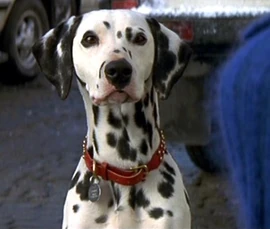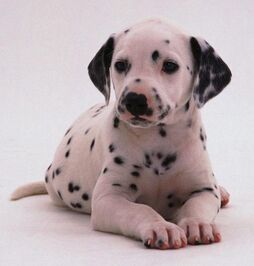| Dalmatains | |
|---|---|
 Adult Dalmatian (Pongo from the "Live-Action" film) | |
|
Other Names |
Carriage Dog Spotted Coach Dog Firehouse Dog Plum Pudding Dog |
|
Nicknames |
Dal, Dally |
|
Country of Origin |
Croatia (Dalmatia) |
|
Coat |
White background |
|
Color |
Black sopts |
|
Litter Size |
6-9 puppies |
|
Life Span |
10-13 years |
Dalmatians are the main dog breed used in the franchise of One Hundred and One Dalmatians.
Description
The Dalmatian is a large, strong, muscular dog. The skull is about as wide as it is long, and flat on the top. The muzzle is about the same length as the top of the skull. The stop is moderate but well defined. The nose can be either black, brown (liver), or blue or a dark gray that looks like black. The teeth meet in a scissors bite. The medium sized round eyes are either brown or blue or a combination of both. The ears are set high, hanging down, gradually tapering to a rounded tip. The chest is deep. The base of the tail is level with the topline and tapers to the tip. The feet are round with arched toes. Toenails are white and/or black in black spotted dogs and brown and/or white in liver spotted dogs. The short coat has fine dense hairs. The symmetrical coat is predominantly white with clearly defined round spots. The spots can be black or brown (liver) which are the preferred colors in the show ring, but can also be, lemon, dark blue, tri colored, brindled, solid white, or sable. Not all of these colors are accepted into the show ring, but they do occur in the breed. The more defined and well distributed the markings are, the more valued the dog is to the show ring. Puppies are born completely white and the spots develop later.
Basic Information
Weight and Height
Height: Dogs 22-24 inches (50-60cm.) Bitches 20-22 inches (50-55cm.)

A real Dalmatian puppy
Weight: about 55 pounds (25 kg.)
Living Conditions
A Dalmatian is not an ideal dog for apartment dwellers unless it can be taken out for a brisk walk or run several times a day. They are very active indoors and will do best with at least an average-sized yard. Not suited to living outside in cold climates.
Life Span
About 10-12 years.
Litter Size
Often large, not uncommon to have up to 15 pups in one litter.
Group
Gun Dog, AKC Non-Sporting.
Origin
There is total disagreement about the origin of this breed. Spotted dogs are known throughout history in Africa, Europe and Asia. The breed may be related to the Pointer. Traces of spotted dogs are found in Egyptian bas-reliefs and Hellenic friezes, so it certainly is an ancient breed. In 1700 a dog known as the Bengal pointer, similar to the Dalmatian, existed in England, calling into question the Dalmatians Yugoslavian origin. Some claim the Dalmatian is a Croatian breed. Efforts to have it recognized as a Croatian breed had been rejected, up until 1993, when the FCI did finally recognize the Croatian roots of the Dalmatian dog, although they continue to deny Croatia standard patronage rights over the breed. In the Middle Ages it was used as a hound. The breed became popular as a carriage dog in the 1800's. They trotted beside and among the horses and carriages, very reliably following their masters, guarding the carriages and horses while the master was occupied elsewhere. Very hardy with great stamina they were able to easily keep up whether its master was on foot, on horseback, or in the carriage. The versatile Dalmatian has seen many uses, such as a mascot for firemen, war sentinel, draft dog, circus performer, vermin hunter, fire-apparatus follower, bird dog, trail hound, retriever, shepherd and as a guard dog.
Grooming
The Dalmatian sheds all year round but does so profusely twice a year. Brush frequently to help manage the constant shedding. They do not have a doggy odor and are said to be clean and even avoid puddles. Bathe only when necessary.